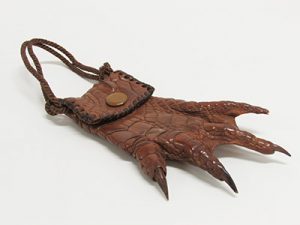ENDANGERED – FAUNA AND FASHION: LEATHER

By Nicole Johnston and Jean Parsons
September 20, 2018
Animal leather has been worn by humankind since prehistoric times not only in the form of clothing but also as accessories like hats, shoes, belts, jewelry and handbags. Often a coproduct of the meat industry, leather can be made from cows, pigs, goats, and sheep, as well as exotic animals such as alligators, ostriches, sharks, and kangaroos. The leather industry plays a prominent role in the world’s economy with an estimated value of approximately $100 billion per year.¹ Demand for leather products fluctuates, however, and as a result of new alternatives developed during recent decades, including textiles, plastics, and other natural or synthetic materials, leather has lost its prime position as one of the world’s most widely traded commodities.

Cellulose and petroleum-based alternatives to animal leather were developed in the late 19th and 20th centuries in the forms of acetate, nylon, acrylic, and polyester. In the 1960s and 70s these alternatives were promoted in response to increasing animal-rights activism and environmental awareness. During the process of tanning leathers and dyeing furs, the many toxic chemicals used frequently make their way into the earth’s water supply. Furthermore, livestock create one-fifth of the world’s greenhouse gases, and an estimated one-third of leather hides produced end up in land fills.² Today, as many consumers are shifting towards sustainability issues, the fashion industry has begun to market its use of real animal hide and skin products as “green” and “ethical” as these products are biodegradable and require less use of chemicals and pesticides than synthetic and many plant-based textiles. The purchase of real animal products is on the rise, particularly with younger consumers.
Designers and scientists continue to explore a variety of alternative natural materials to replace animal leather in fashion. For example, in 2018 Modern Meadow introduced Zoa™, a bioleather material fabricated through a process of DNA editing that grows collagen – the protein in skin – from yeast. Learn more about this and other alternatives to animal leather in the ALTERNATIVES category on the Origins-Dress and Textiles homepage.
- JCR-VIS Credit Rating Company Limited; October 2017. Accessed 7.9.2018.
- Wicker, Alden. Inc. Magazine. March/April 2018. Accessed 8.9.2018.















Return to Endangered: Fauna and Fashion homepage
Return to Origins: Dress and Textiles homepage